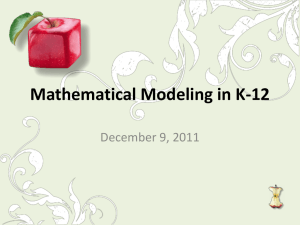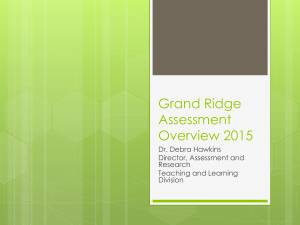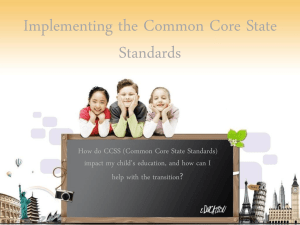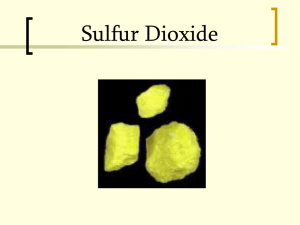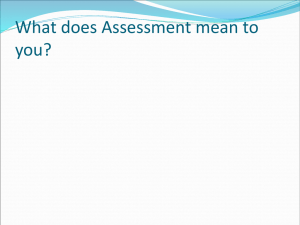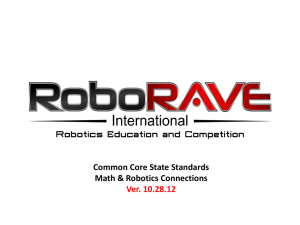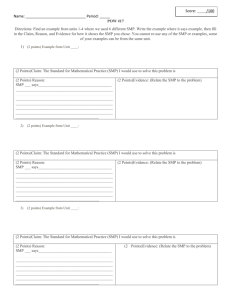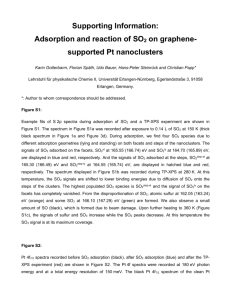EGUSD CCSS/Go Math! Third Grade PreService 2013 PowerPoint
advertisement
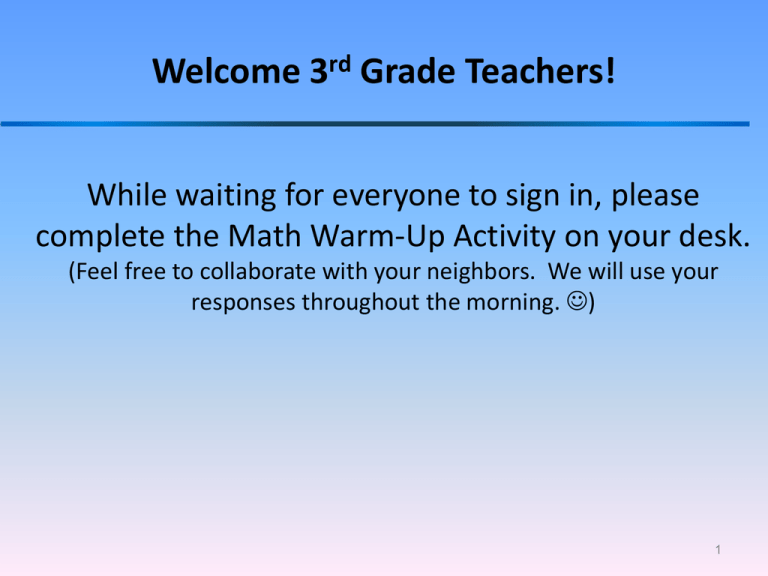
Welcome 3rd Grade Teachers! While waiting for everyone to sign in, please complete the Math Warm-Up Activity on your desk. (Feel free to collaborate with your neighbors. We will use your responses throughout the morning. ) 1 Preparing Students for College and Career Readiness Pre-Service 2013 3rd Grade Mathematics Common Core State Standards and Go Math! Presented by: Steve Kolb, K-12 Instructional Coach Curriculum/Professional Learning Pat Gibson, Teacher Leader Foulks Ranch Elementary Alexandra Condon, K-12 Instructional Coach Curriculum/Professional Learning Karen Torres, Teacher Leader Prairie Elementary 2 Welcome Back! 3 4 Students Reflect: CCSS-m & Go Math! 5 Norms Be invested. Collaborate with colleagues. Avoid sidebar conversations. Turn your cell phone to silent. Please step outside if you have an emergency and need to text. 6 Overview Spring/Summer Trainings Day 1: • CCSS math – Rationale – Content standards – Standards for Mathematical Practice • Instructional shifts required 7 Overview Spring/Summer Trainings Day 2: • Go Math! – Components – Online Resources – Daily Lesson Design – CCSS & Marginalia • Field Testers – Sharing of Experiences – Tips and Traps 8 Overview Spring / Summer Trainings Day 3: Pre-Service (Today ) • Student Engagement – Class vs. Individual – Standards for Mathematical Practice • Parents & CCSS – Parent University Models – Supporting Parents • Assessments – GoMath! Options – District Shifts • Lesson Planning 9 Turning up our dimmer switch 10 Today’s Outcomes Build our understanding of: • Student engagement - what math will look/sound like in CCSS classrooms • Assessments that are available and which will best fit our instruction in year one of implementation • Parents’ needs with the CCSS-Math transition • CCSS-M planning and lesson design 11 Review of the 8 Standards for Mathematical Practice 12 Standards for Mathematical Practice (SMP) 1. Make sense of problems and persevere in solving them. 2. Reason abstractly and quantitatively. 3. Construct viable arguments and critiques the reasoning of others. 4. Model with mathematics. 5. Use appropriate tools strategically. 6. Attend to precision. 7. Look for and make sense of structure. 8. Look for and express regularity in repeated reasoning. 13 SMP Practice Activity 14 SMP #2: Reason abstractly and SMP SMP SMP SMP #8: #3:#1: #7: Look Construct Makes Look for and for sense viable and express of make arguments problems regularity use ofand SMP #6: Attend to precision. SMP #5: Use appropriate tools strategically. SMP #4: Model with mathematics. critique andin persevere repeated thestructure. reasoning in reasoning. solving of them. others. Which Standard? quantitatively. Willisthat methodasking? always work? What the problem How will you use know? that that information? How do you What is a situation could be by this How do you know your answer isrepresented reasonable? What Why could is that you a use good to model help you for solve this problem? the problem? What other do youabout…? need? What do you equation? How didinformation youremember discover that pattern? What do you think about what she said? How can you use math vocabulary in your explanation? Why did you choose that What How strategy can you could use you aoperation? simpler use toproblem make that to calculation help you What operation did you use to represent the situation? What happens when…? Who can tellway us about athat different method? What other patterns can you find? What is another to solve problem? easier? Howfind do the you answer? know those answers are equivalent? Why does that operation represent the situation? What did you do first? Why? What do you think will happen if …? if you…instead of …? What rule did you use to make this group? How What would conclusions estimation can help you you make solve from that your problem? What does that mean? What can you do ifthat you not don’tbe know how tothe solve a problem? What properties did you use to find answer? When would true? model? What might beproblem a shortcut for …? Why can you use that property this problem? Have you solved a similar to Why did you decide to use…? thisinone? How dodo youyou know your answerwith is reasonable? Why agree/disagree whatnot hework said?for this When did you realize your first method would How would you change your model if…? How is that like…? problem? What do you want to ask her about that method? How do you know your answer makes sense? How does that drawing support your work? 15 Productive Partners Use the 4 Ls: 1. L = Look at your partner. 2. L = Lean toward your partner. 3. L = Lower your voice. 4. L = Listen attentively. This poster & great other ELL STUFF!!! Structured Student Interaction slides courtesy of Dr. Kate Kinsella, San Francisco State University, Center for Teacher Efficacy http://blogs.egusd.net/win/ 16 SMP Practice Activity-Reflection Share Use the 4 Ls: 1. L = Look 2. L = Lean 3. L = Lower 4. L = Listen I feel confident about supporting my students with Standard for Mathematical Practice # ____, because I ___________. The Standard for Mathematical Practice # ____ will be more challenging for me to implement right away because _______. 17 Getting Engaged with Learning: Starts with Thinking What is the mathematical concept that connects all three of these problems? 6 x 98 = 6 100 2 6 x 7⅔ = 2 6 7 3 or 588 1 6 8 3 48 2 46 6 2 x 3 12 x 18 Getting Engaged with Learning: Requires Learners Talking Use the distributive property to evaluate these expressions. #1.) #2.) 8 x 199 = #3.) 8 4 7 8 3x 2 8 Something I see in problem # ___ is ____________. The first thing I would do to complete problem # ____ is _____________ because______________________. Problem # ______ makes me wonder _________________. Students Engaged in the CCSS Classroom! • • • • • • • ALL students communicating thinking ALL students are doing most of the talking ALL students discovering concepts ALL students practicing applying concepts ALL students learning from others ALL students using errors as an opportunity to learn ALL students using sentence frames and sentence stems to practice expressing new ideas • Teachers questioning to support/encourage thinking • Teachers celebrating student thinking and learning 20 Planning for Student Engagement SMPs-Go Math! • Look at a lesson in chapter 1. • Read the questions in the marginalia. • How do these questions support the 8 Standards for Mathematical Practice? • How will you get ALL students engaged? • How will you get ALL students thinking? • Which questions do you anticipate being challenging for students? What will you do? • What is a specific engagement strategy you will teach your students in support of the SMP? 21 Group Share Out Using 3 Ls: L = Look at the speaker. L = Lean toward the speaker. L = Listen attentively. We will know our students are engaged in chapter ___ lesson ___ when they _________. During the _______ section of Chapter ___ Lesson __, our students will respond to questions by __________. We are planning on teaching our students to respond by ___________ because ____________. Group____ told us they will ____________. Then _____ told us they will…..We will ____ 22 Supporting Our Community YOU ARE NOT ALONE! 23 Parents & CCSS • Parent University Model Update – Piloting this fall – Elementary Math Steering Committee – Goal is for District Model(For Schools to Use) 24 Parents & CCSS “They need to decideeven which “These kids couldn’t dosubject CA they“Common are assessing-reading, writing, or Standards; they’ll never be able to do Core? UGH!” “This is impossibly hard!” math?!” these new standards!” How do comments like these affect our work? 25 Parents & CCSS •Supporting Parents-Supports Our Students – Positive messages – Recognizing “change” can be uncomfortable/scary – Encourage strategies for helping students to help themselves and “think” – SMP – Patience, persistence, & positivity Before break… 26 Break 27 A glimpse at being career ready… Play 28 Let’s Practice How would you respond to this question? “If my child already knows their math facts and how to multiply, why would you have them learn it another way?” 29 Traditional 4 2 48 Method #2 48 x 53 Method #3 40 + 8 40 + 8 50 2000 400 50 + 3 53 24 + 14 4 Alternative 120to a 24 3 120 lead students 240 ways to solve problems, 400 deeper math understanding and prepare them for higher 2000 level2,544 mathematics. 2,544 30 3 1 10 5 Traditional 16 5 496 =? 15 3 Method #2 1 3 5 31 3 1 10 30 2 1 1 15 1 3 33 1 Method #3 1 1 3 10 5 3 30 + 1 + 2 + 1 15 15 Alternative ways to solve problems, lead students to a deeper math understanding and prepare them for higher level 31 mathematics. The algebra connection x 3 x 2 2 x 5 x x 3 x 2 3 3x 2 x 5 2x 2 6x 2 5x 15 X3 + 5x2 +11x + 15 32 Why is learning multiple methods important? •Students need to develop skills & strategies that allow them to MAKE DECISIONS about the MOST EFFICIENT way to solve a problem •Students need to develop a deeper (more rigorous) conceptual understanding of “number sense” •Students need to develop skills and strategies that will prepare them for more advanced mathematical thinking and applications •Students need to be able to clearly communicate why something works (or doesn’t work) and explain the reason for the decisions they make •Students need to become mathematically proficient in order to be college and career ready 33 Another Opportunity How would you respond to this question? “If my child already knows their math facts and how to multiply, why would you have them learn it another way?” 34 Resources for Supporting Parents with CCSS & Go Math • Go Math website • EGUSD blog • Standards for Mathematical Practice Questioning Examples (located in the Go Math Planning Guide) 35 What resources are provided to monitor, assess, and support student progress? 36 Assessment Guide Prerequisite Diagnostic Skills Beginning of the Year Test (BoY) Middle of the Year Test (MoY) End of the Year Test (EoY) Diagnostic Interview Assessments Chapter Tests (2 formats) Constructed Response Extended Constructed Response Performance Assessments Correlations On-line Assessment 37 Show What You Know 38 Step 3: Practice 39 Mid-Chapter Checkpoint 40 Chapter Review/Test 41 Online 42 EGMAP Benchmark Assessments (Elk Grove Measure of Academic Progress) eCPL 43 Assessments Dig in & Discuss 44 • Which assessments will we use as a grade level team for common assessments? • Will we use an assessment for identifying student needs to start the year? If so, which one? • What are some of the advantages and disadvantages of forms A and B? • Looking closely at chapter one and all assessment options, which assessment(s) will we use? • How will we handle grading? • When/How will our grade level use information from each assessment opportunity? 45 Group Share Out Using 3 Ls: L = Look at the speaker. L = Lean toward the speaker. L = Listen attentively. • The ______ assessment seems valuable to us because ______. • We anticipate the ____ assessment giving us valuable feedback to guide our instruction. • Another assessment that stood out for us was ____ because ______. • We are going to try to use the ______ assessment regularly to give us instant feedback. 46 Lesson Design Chapter 1, Lesson 1 & Most Difficult Lesson in Chapter 1 • • • • What is the essential question? What will kids have to know to answer that? What is being taught and what do they need to already know? Which additional support/knowledge do we need in order to be most effective at helping our students conceptually understand? • How will we get ALL students talking and engaged in every part of lesson? • How will we support our English Language Learners? – ELL components? • How will we support our students who are below grade level or struggling? – RtI (Response to Intervention components)? • When/How will we know our students are learning? 47 Afternoon Agenda 1:00-3:30 Continue with Go Math! Lesson Planning Here OR Your Site 48 Feedback to Inform our Next Steps 49 Lunch! Go Math! Planning! 50

